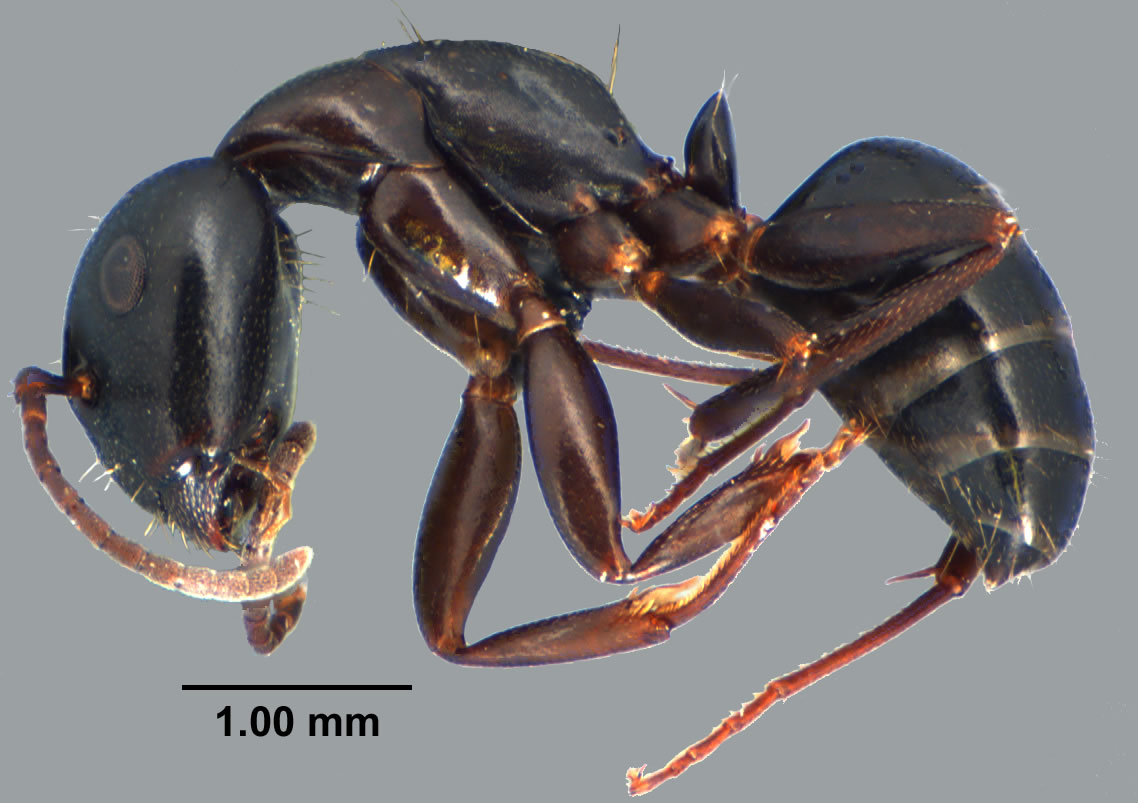Subfamily FORMICINAE |
|
Camponotus nearcticus, full face view of a major worker (click image to enlarge). |
Camponotus nearcticus, profile view of a major worker (click image to enlarge). |
Ants in the genus Camponotus are collectively known as carpenter ants because some species nest in wood, including man-made structure. This genus includes some of the largest and most common ants in the world, and they are found in all biogeographical regions (Bolton, 1995). More than 900 species of Camponotus are known worldwide, with 50 species reported from the United States (Hanson and Klotz, 2005), and 20 species found east of the Mississippi River (Deyrup, 2003; Smith, 1979). Species in this genus are variable in size with workers ranging in size from 3 to 15 mm or more in length and queens (also referred to as females) of some species attaining a length of 19 mm or more. Many species are polymorphic. Workers have a 12-segmented antenna that lacks an apical club. Antennal fossae do not touch the posterior border of the clypeus. Ocelli are not present on the heads of workers. The workers of most species have an indistinct metanotal suture between the promesonotum and the propodeum, although this suture is present in C. sexguttatus and some members of the subgenus Colobopsis. Those species that lack the obvious and deep metanotal suture have the shape of the alitrunk in a smoothly curved arc (as seen in profile). This species is in the subgenus Myrmentoma, which can be generally characterized as having a notch or emargination in the middle of the anterior border of the clypeus. Camponotus nearcticus Emery workers range from 3.5 to 7.5 mm in overall length. This species can be distinguished from others in the subgenus by the lack of erect hairs on the gena, scarcity of erect hairs on the clypeal disc, and by its color which is a concolorous dark brown to black. Some consider this species, C. snellingi, and C. decipiens color forms and in that case the name Camponotus nearcticus has priority. Camponotus snellingi specimens tend to be larger in overall size, and individuals have similar coloration to C. decipiens, although the gaster of C. decipiens is black. C. snellingi usually has larger nests as well, and are frequently found in large colonies in dead trees, often still standing. This widespread species nests in a wide variety of places such as dead twigs and branches of trees, hollow stems, logs and stumps, in or beneath the bark of both living and dead trees, in insect galls, pine cones, wooden posts, and woodwork of buildings, especially in the roofing (Smith, 1965). Alates have been collected in Mississippi from early April through mid June. Although this species is said to be widespread, we only rarely encounter it in the field. This is probably due to its nesting habits, as it appears to be primarily arboreal. It is possible that it is more active at night or at least during the periods of the day when temperatures are lower. Much of the collecting for ants is done during the daytime and more nocturnal species could be missed. Typically, when I have collected this species, I have found them on vegetation or collected them beating vegetation. However, at 7:00 A.M. on 26 April 2006, I observed this species a plenty, crawling on the ground in a very loose column. The ants were seen in front of the department of Entomology and Plant Pathology on the Mississippi State University campus in Oktibbeha County, MS. The column consisted of both majors and minors, and these workers were heading to an old pine tree (Pinus taeda), which they continued to climb to a height where it was no longer possible to observe them. I assumed that they were nesting somewhere up in the tree, but unfortunately it was too high for me to investigate further. Not to mention, the university grounds people would probably frown upon my mutilating a tree just to look for an ant nest. I was not able to ascertain the beginning point of the ant column, but I did follow them for approximately 10 meters to a mulched butterfly garden area. I introduced some cookie crumbs to the column (Keebler Pecan Sandies), but the ants did not seem interested in them. On a prior occasion I had observed a dealate queen in this same location. |
|




